New details have been published alongside the illustrations for a five-story affordable housing project at 1601 69th Street in East Sacramento. The plan will replace a vacant acre-wide parcel near CSU Sacramento and light-rail with 90 apartments. Carlsbad-based Chelsea Investment is responsible for the application.
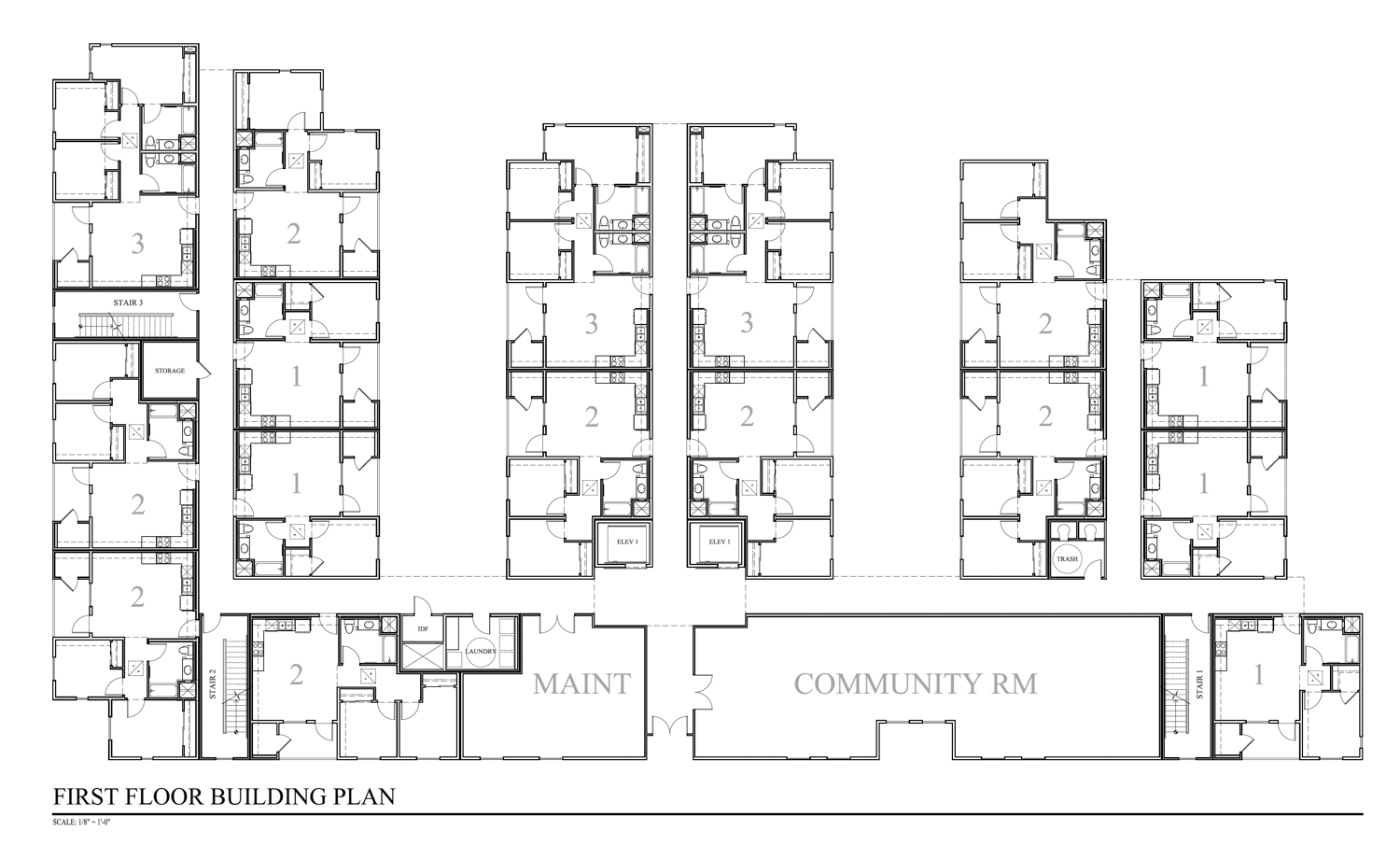
1601 69th Street ground-level floor plan, illustration by McKinley Associates
The McKinley Associates are responsible for the design. Illustrations show the boxy E-shaped apartment complex sitting in the center of the abnormally shaped parcel, carved on the east end by the Southern Pacific Railroad tracks. The parking on-ramp will be located on the eastern end of 69th Street, bringing residents down to the basement-level 46-car garage. The ground level includes a maintenance room and community facility. Apartment sizes will vary with 23 one-bedrooms, 44 two-bedrooms, and 23 three-bedrooms. All units will include a private patio or deck.
The sparsely-detailed application does not give any further information about the architectural style and landscaping. The San Diego-based studio provides little information about its portfolio online, which primarily shows images of typical suburban-style homes.
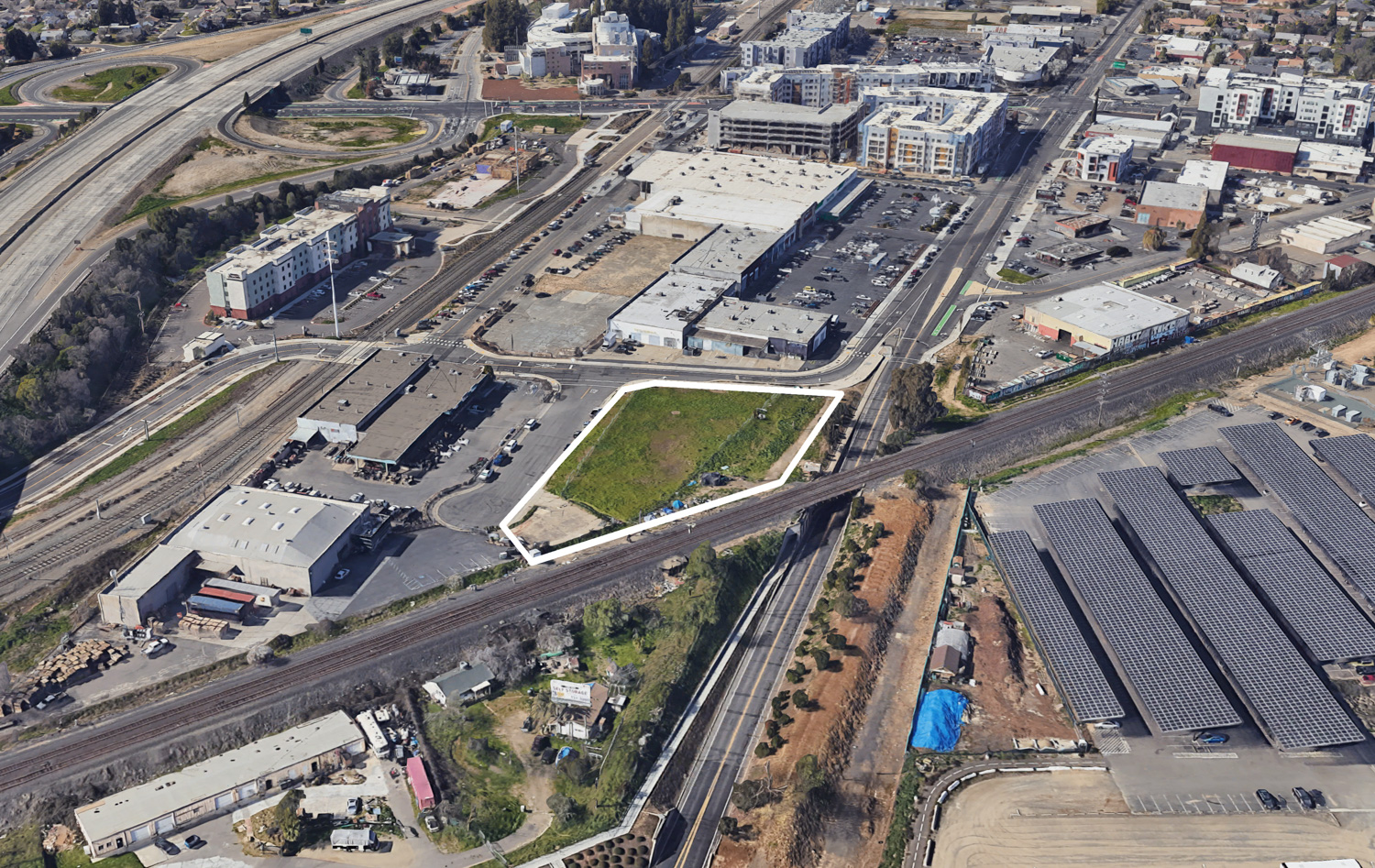
1601 69th Street, image via Google Satellite
The 0.97-acre parcel is located along 69th Street between Folsom Boulevard, train tracks, and the U.S. 50 Freeway. Future residents will be close to various shops, a grocery store, the University/65th Street Station light rail station, the recently-complete Wexler Apartments and the CSU Sacramento campus.
Subscribe to YIMBY’s daily e-mail
Follow YIMBYgram for real-time photo updates
Like YIMBY on Facebook
Follow YIMBY’s Twitter for the latest in YIMBYnews

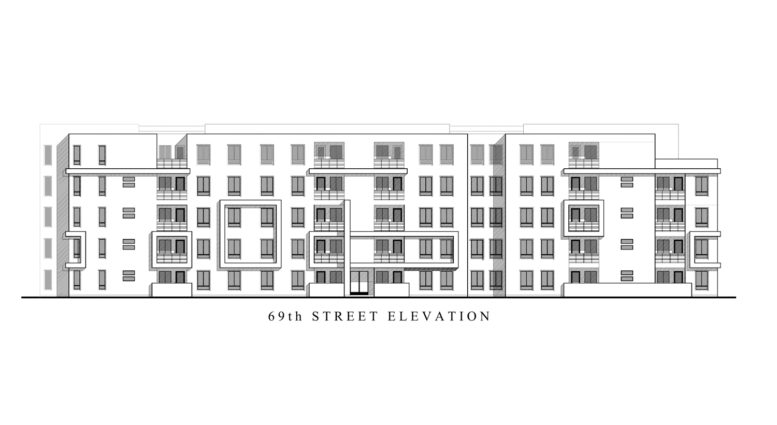
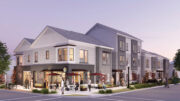
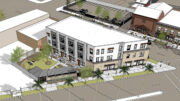
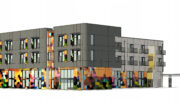

Awful… Throw stick-um frames and pilasters onto a Bauhaus box…. yeah, that’s “design”. BTW… missing elevator and stair penthouses on the elevations…. and really lousy unit plans with minimal storage.
With inflation & construction cost rising, & banks too afraid to invest & the economic forecast, be lucky if this project even goes up. This is an affordable housing project, this is t the billionaires row in 57th in Central Park (New York City), I don’t understand why everyone expects these small budget projects in Sacramento to be iconic world architectural marvels of the world. I said this many times, be a developer and see how difficult it is to develop a project, especially at this scale, in the Sacramento market.
Say it again and again… We understand your point, but we are tired of seeing the same “design” over and over.
If it costs too much (or “doesn’t pencil”) for Sacramento to get better design, then it simply costs too much to build, and we should take a break for a while.
Again, focus on smaller, alley-facing projects.
However, we cannot let another great site get chewed up by the same, ugly building. We cannot allow restaurant, retail, and entertainment spaces that engage the public go by the wayside. We have to say, “NO!”
If you are tired of seeing the design over and over again, become an architect or do something about it instead of whining. Do you really understand? Do you really understand this side of the industry? At the end of the day, these developers are business men and women, this isn’t Sim City. They have to work with already the rigorous planning committees, environmental bylaws, design reviews, etc. There is so much behind the scenes that most do not see. Bottom line, if a developer can not see financial gains, they will not proceed with the project.
“If it cost too much for Sacramento to get better design, then it simply costs too much to build, and we should take a break for a while”…. So we are just not going to build anything while demand for housing increases, cost of construction and living increases, and land is sitting to rot? What an ill-advised opinion. Its a good thing you are not in charge of projects and developments or city planning.
Theres 2 kinds of people in this world, those who complain about wanting something, and those who go out there and get it.
I’ve seen responses like yours multiple times… “If you don’t like it, become an architect or developer.” And “This isn’t Sim City.” And “Quit whining. It’s not your money!” (They may all be from you!)
Responses like that annoy me to no end, because they assume that I am just a gadfly who knows nothing and hates development.
Being pro-development does not mean I have to support utter crap, especially since I think it is time for Sacramento to get better projects.
The thing is, we can’t all be architects and developers. (Unfortunately for my bank account, we can’t all be contractors and construction laborers either.)
You see, I don’t have to be an architect to know what good design looks like and recognize that most new developments and proposals look the same – I have eyes.
And I don’t have to be in the construction industry to understand what the economics are – I can read.
Furthermore, I don’t have to be a developer to know the pressures and costs – I know about California’s onerous regulations, and I understand how the market works.
As a member of the public, I have every right to be interested in and criticize development proposals. I don’t think we should rubber stamp every anemic development that comes down the pike. These buildings do affect the community:
Like it or not, these buildings are ambassadors for Sacramento. These large, gray-on-beige developments aren’t going to look very good a decade from now. Remember the awful “Tuscan” single-family home craze from the early 2000s? Well, at least those homes are buried in suburban cul-de-sacs. These “urban-lite” Bauhaus Boxes will be front and center to anyone who visits the city. For larger, high-profile, higher-value, street-facing developments, we have to demand better.
Additionally, I am concerned that developers are eschewing the mixed-use concept and focusing on housing-only buildings. The central city’s purpose is to be mixed-use. If we pile enough of these apartment/condo-only projects on top of one another, the city will be more like a suburb with mostly “urban-looking” apartment buildings, some office, some retail, and a Capitol Building. I understand that many retail spaces are currently sitting empty, but markets ebb and flow. With enough residential units and with enough office space (it may not return in the same way, but office will make a comeback), retail space demand will increase. All those people are going to want food to eat, items to buy, and places to go and be entertained. Suburbanites will also come back to the city. Downtown and midtown must offer more than blocks of residential-only buildings. But that is just what we’ll have if we don’t stand up to housing-only proposals in the central city.
Although it does not apply to this project (I have no concern’s about this project’s height), I am also getting tired of developers proposing buildings that a more appropriate for midtown in the downtown area and buildings that are more appropriate for East Sac and Broadway in the midtown area. To contain a large amount of residential units, many of these stubby proposals must sprawl outward. As a result, vast swaths of valuable land will have nothing but low-rise apartment buildings that sort of look “urban.” When developers do feel like building good stuff, where will they build?
Case in point: In midtown, on the former site of the Sacramento Bee headquarters, a developer has proposed 538 residential units. The proposal consists of two, block-sized, 5-story buildings. (By the way, 38% of the space will be dedicated to parking.) None of the buildings would have ground floor restaurant, retail, or entertainment spaces to engage the public. However, there would be a “paseo” between the two buildings. Oh my gosh… A paseo?! How wonderful! That’s way better than a bar, a small, bodega-style market, a couple restaurants, a music venue, or even a theater. Where does this amazing paseo lead? Well, it leads to a parking lot on R street… So, nowhere. Both buildings have exact the same, Developer Modernist style. At least the color scheme is ok, but I am sure that will value-engineered out of the design. Instead of breaking up the property into entitled half-block or even quarter-block-sized parcels, selling most of them off to other developers, and building something with better scale for the area, the developer wants to eat up two blocks’ worth of high-value, midtown property and build more of “The Same.” The developer won’t even consider ground floor public spaces (except for that stupid paseo). According to the developer, existing retail spaces and other projects in the pipeline should take care of any demand for retail space. However, that is very short-sighted… With 538 units, plus the potential for more, plus all the other residential units in the area, more retail could be supported. Furthermore, as you point out, there are no guarantees that any of these proposals will get built due to rising costs and higher than normal (still, artificially low) interest rates. From the street, these imposing “sprawlscrapers” are not inviting. Nobody, except for those who live there, will engage with those buildings. The public will just walk or drive past. Maybe a few individuals will stroll the paseo to an uninviting parking lot on R Street, but that’s about it. We don’t have an unending supply of high-value, street-facing, large sites. We should not fill them up with the same thing.
If these proposals were interesting/had better design, if they included a mix of uses to engage the entire community, and if they were taller (in certain areas), you’d get zero arguments from me. (Downtown proposals would still have to be taller than 8 floors, though.)
I actually know more than you assume. I have been following development, studying development and participating in Sacramento development projects for 20 years. I attended “Charettes” and planning parties hosted by former Mayors Fargo and Johnson. So, I understand the challenges that developers face.
I am well aware that construction prices are way out of hand right now. I also understand that interest rates aren’t as artificially low as they used to be. (By the way, how did developers manage to construct towers and good-looking buildings in decades past, when interest rates were much higher?)
When prices are too high, the demand side MUST stop participating in the market. Otherwise, there is no reason to participate. If the supply side can dictate the market (if only one side can dictate the market), then we are in trouble.
Regarding the need for housing: First, I provided a solution, one that is far cheaper than these larger, ugly, street-facing projects – Focus on the alleys. Sacramento has miles of alleyways that are excellent candidates for smaller apartment complexes and ADUs. In fact, Sacramento has an “Alley Activation” plan that (if followed) could add 1000s of housing units. Additionally, there are multiple smaller sites that are great candidates for housing. Some of my favorite developments are from a company called Indie Capital. Yeah, their designs are still modernist. However, they do have a nice flare them. Their multi-unit projects even include a small retail space. I have no complaints. Then, there are companies like Bhandal Construction… Again, they build on tiny properties, and I think they even plan on building an alley project or two. These projects don’t bother me because the developers don’t plan on filling high-value, street-facing, large parcels with low-rise developments.
Furthermore, I don’t think the housing crisis is as dire as you think. Thanks to the new, palatial state office projects, we have numerous empty or under-used office buildings that could be converted to housing. Yes, office-to-housing conversions would be expensive, but not as costly as constructing an entirely new building. Finally, most homeless people are either drug-addicted or crazy. You can’t expect these people to maintain a household – They are incapable of doing such a thing… They should be institutionalized.
On the supply side of things…
The government (federal, state, and local) has really screwed us over:
First of all, I keep talking about artificially-low interest rates… Because of the federal reserve bank’s stupid monetary policy, we have inflation and boom-bust cycles. If interest rates were to roam free (as they should) and if money were not so easy to get, we’d be playing on more level field. Building towers downtown would not cost unattainable amounts. Heck, back when the Towers on Capitol Mall failed, one of the big contributing factors was the increasing price. Back then twin, 52-story towers would cost around $350 to $450 million. Today, you couldn’t build a single tower for that much. On 10th and K Streets, the Mohanna Development Company has proposed a 15-story mixed-use tower. I’ll bet the current estimate for that project is at least $120 million. So, at current prices, the Mohanna project, which also has a small footprint, costs 70% more per story than a 53-story project from 15 years ago. Construction price inflation is out of control. The Fed has a lot to do with this.
Second, another big reason for rising construction prices is a dearth of labor. We have a big problem in this country with too many people going to college and not enough going into the trades. For some reason, a lot of high school graduates would rather attend college, get a useless degree in Lesbian Dance Theory, and pull espresso shots for a living, than become plumbers, electricians, and carpenters. Consequently, labor costs are too high. Certainly, the every child should go to college attitude and easily attainable federal student loans are a be reason for this. However, we should also consider that when construction market fell like a rock in 2007/2008 due to the last economic downturn, construction laborers left the market and never returned. Most people want to blame private business for the housing bubble. However, there would have never been any reason to loan out money like it was going out style without the Fed’s terrible monetary policy. Again, government f**ks everything up.
Third, I also spoke of government building projects… Government always overpays for buildings, roads, etc. For example, the recent state office building projects cost billions of dollars. Based on what we’re getting for the money, we’re overpaying, significantly. Add in the fact that government often funds “private” developments with grants, and the problem is even worse. On SF YIMBY, I read about an approximately 60-unit affordable apartment project that a developer in the Bay Are is building. Most of the funds are coming from state (and maybe federal) grants. The total price for the development is about $75 to $80 million – That is over $1.2 million per apartment. When there are unlimited government dollars chasing after limited contractors and construction laborers, there is no incentive for “supply” to lower its prices. If government did not spend so much on construction projects, construction prices would be lower. Again, government f**ks things up.
Fourth, government regulations increase building costs. We have requirements for solar. We have CEQA (though the governor is trying to decrease its teeth). We have strong earthquake standards, which aren’t as necessary for cities like Sacramento. The harder it is build, the more expensive it is to build. Here we go yet again… Government f**ks things up!
Regardless, of your feeling toward the government, we need is a solution to the problem of high construction prices or even these low quality projects won’t move forward. However, I don’t think it’s wise to move forward with proposals that are lower quality just because, “We have to build something.” It’s giving in. Again, we don’t have an unlimited quantity of good, large, street-facing properties. Restaurant, retail, bar, and entertainment establishments will come back. Office will also come back. Let’s leave the good sites for better projects. I think Sacramento needs to start putting limitations on certain properties: Minimum Heights (not Maximum); Mixed-Use Required; and Design Standards.
If low-rise housing-only is necessary, there are other places where it can go.
I must say, if this were 10 years ago, I would agree with you wholeheartedly. However, after years of seeing the same “design philosophy” over and over again, I am all “Bauhaus Boxed out.” I don’t want to see this crap anymore.
Speaking of 10 years ago, back then inquired with developers about most proposals’ lack of height. They told me to wait a while… Once Sacramento proved itself, we’d get taller buildings. Well, Sacramento has proven itself, but developers are not risking to build taller. It’s time for them to take bigger chances, at least if they want to build on high-profile properties. I am not saying they should build twin 52-story buildings, but they can do better than 5 to 8 floors.
Furthermore, if you’re going to add 100+ residents, you must give them something to do, some place to eat, something to buy, or a small market where they can purchase groceries, etc. Especially for higher-profile street-facing properties, we can’t allow developers to favor housing-only over mixed-use.
I have to agree… These proposals are all the same. Just more “Developer Modernism,” eating up another great site.
Furthermore, it’s clear that this proposal includes zero ground-floor restaurant, retail, or entertainment spaces to engage the public. Just about every proposal within the central city should be mixed-use. Right now, times are tough for restaurant, retail, and entertainment spaces, but the times won’t always be tough. Developers should be planning for the future. Plus, I am sure that CSUS students would like another bar, lower-priced restaurant, small grocery store, etc. Given all the new housing in that area (not to mention the existing East Sac residents), adding more spaces that the public can access is a good idea.
I understand that construction prices are ridiculous. I understand that these “Bauhaus boxes” (I like that description… I will steal it ;)) are what developers can afford, especially in the Sacramento area, which does not have the same level of wealth as the Bay Area.
I also understand that we need more housing.
However, we can’t sit back anymore and let developers put up these stinker buildings. It’s not that they have zero design… They NO design. These projects are simply copy and paste jobs. They are “cheaply” (I know they’re expensive) and poorly build, and you can’t tell one apart from the other.
I live in a Bauhaus box (my building is larger and taller), and I can tell you that it’s a terrible living experience. Roaches everywhere (they shorted out my expensive sound system), leaking pipes, the pool leaks, and the walls are starting to settle – we can’t even shut our doors anymore.
We cannot let our desire for more construction and more housing cloud our judgement. These buildings are ugly, a waste of good land, and will do very little to distinguish Sacramento from every other city. (Well, at least other cities get taller buildings.) We are going to regret these cheap-o, ugly buildings.
To those of you who want more housing, here is my solution: Focus on the alleyways. A s**t-ton of smaller, lower-priced alley-facing ADUs and apartments could add thousands of housing units to the central city. Then, we can save these prime, street-facing lots for a time when construction prices, interest rates, and the retail (and office) space market has stabilized. We can save them for better design.
Matt…. I am an award-winning architect…. and have also developed a few modest-sized multi-family buildngs…. and designed and built many more over the past 25 years from 4-units to 300 units…. and your arguments, while having some solid foundation (‘scuse the pun) do not excuse bad design. Design is not just about how much things cost, or the challenges faced by developers and planners…. it is also how to create lasting aesthetic value and consideration of and for that space on the earth you propose to occupy with your “design”…. and for many years to come.